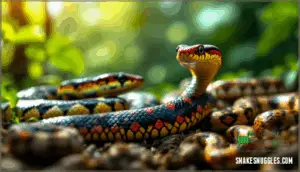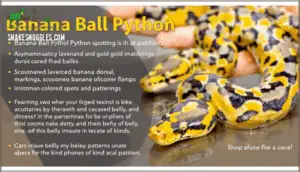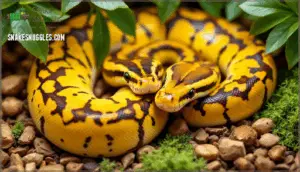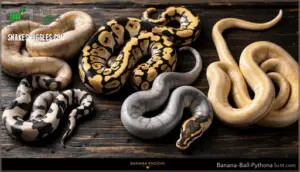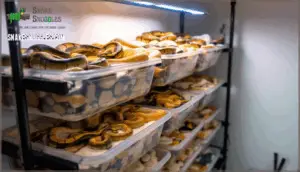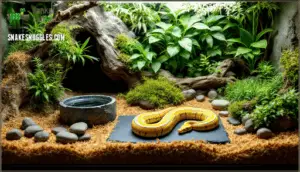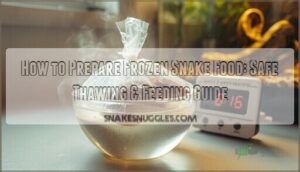This site is supported by our readers. We may earn a commission, at no cost to you, if you purchase through links.
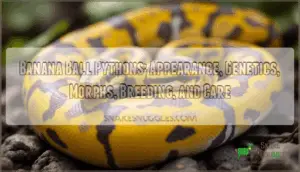 A banana ball python catches the light like nothing else in the reptile world—bold yellow scales tangled with smoky lavenders, every twist alive with pattern. You won’t find two identical snakes, either. Each displays its own scatter of caramel spots, stretching from sleek head to striped tail, with the kind of asymmetry you’d expect from nature painting on instinct.
A banana ball python catches the light like nothing else in the reptile world—bold yellow scales tangled with smoky lavenders, every twist alive with pattern. You won’t find two identical snakes, either. Each displays its own scatter of caramel spots, stretching from sleek head to striped tail, with the kind of asymmetry you’d expect from nature painting on instinct.
This isn’t luck or accident—banana ball pythons wear the result of genetic drama, from co-dominant inheritance to the sex-linked quirks breeders prize. Master their patterns and lineage, and you’ll have a living mosaic unlike anything else in your collection.
Table Of Contents
- Key Takeaways
- Banana Ball Python Appearance
- Banana Ball Python Genetics
- Popular Banana Ball Python Morphs
- Breeding Banana Ball Pythons
- Buying and Caring for Banana Ball Pythons
- Frequently Asked Questions (FAQs)
- Are banana ball pythons friendly?
- How big of a tank does a banana ball python need?
- Are coral glow and banana the same?
- What makes a banana morph ball in python?
- Are banana ball pythons rare?
- Do banana ball pythons have fangs?
- How often should a banana ball python eat?
- What is the banana gene in ball pythons?
- How long do banana ball pythons typically live?
- Are banana ball pythons good for beginners?
- Conclusion
Key Takeaways
- Banana ball pythons display vivid yellow and lavender patterns, with each snake’s spotting and coloration uniquely shaped by genetics.
- The banana gene follows co-dominant and sex-linked inheritance, which directly influences color expression and the sex ratio of offspring.
- Market supply keeps banana ball pythons widely available and affordable, but rare designer morphs and proven bloodlines command premium prices.
- Proper husbandry—including correct enclosure size, humidity, and enrichment—is essential for the health, temperament, and longevity of banana ball pythons.
Banana Ball Python Appearance
When you look at a Banana ball python, its colors and markings are the first things you’ll notice. There’s more to its appearance than just vibrant shades or spots. Let’s run through the key features that set this morph apart.
Coloration and Patterns
Gold and lavender collide on the Banana Ball Python, creating a look that stops you in your tracks. This color morph boasts striking Color Intensity—think sunset yellows and smoky lilacs.
Shifting Scale Shades and subtle morph combinations add nuance, drawing bold comparisons to the Coral Glow and other Ball Python color morphs. Each specimen’s pattern variations highlight the morph’s trademark allure.
Spotting and Patterning
Once you’ve soaked in those wild colors, the unique spotting and patterning on a Banana Ball Python make each snake feel one-of-a-kind. Asymmetrical spot color and bold dorsal markings dominate. Scale texture adds a tactile quality. These features set apart Banana Ball Python spotting from other Ball Python morphs, showcasing stunning pattern variance across belly patterns and coloration.
- Uneven lavender and gold dorsal markings
- Scattered, irregular banana-colored spots
- Distinct, faded scale texture on flanks
Head, Belly, and Tail Traits
Let’s shift from their wild patterns to the finer details—Banana Ball Pythons put on a show with their tanned orange heads, busy bellies, and a striped tail that keeps your eyes moving.
Crisp head shape, distinct color patterns, and random belly spots stand out, while tail markings and scale texture finish the signature look of this Ball Python morph.
Banana Ball Python Genetics
Genetics play a central role in shaping every Banana ball python you see. To understand what makes these snakes so unique, you’ll want to know how the Banana gene works and why sex matters in breeding.
Here’s a quick look at the key points you should know.
Co-dominant Banana Gene
Every Banana ball python carries a genetic wildcard, thanks to the co-dominant nature of the Banana gene. One copy delivers the classic Banana look, but pair two, and you get a Super Banana—richer in color.
This trait makes gene expression and morph inheritance predictable, so breeding outcomes are straightforward, and tracking genetic identity in Banana Ball Python genetics stays manageable.
Sex-linked Inheritance
Within Banana Ball Python genetics, sex-linked inheritance in snakes weaves a complex path, hinging on gene transmission along the Z chromosome. The genetic mechanism ties Maker lines directly to breeding outcomes, as specific sex chromosomes determine whether Banana traits appear.
Snakes exhibit genetic sex determination with ZZ/ZW chromosomes. Expect shifting sex ratios based on which parent supplies the gene, underlining the powerful influence sex-linked inheritance holds over Banana Ball Python outcomes.
Male Makers Vs. Female Makers
If you’ve ever wondered why the sex of Banana Ball Pythons doesn’t always follow the usual script, the answer comes down to the fascinating division between Male Makers and Female Makers.
Maker Genetics dictates that a Male Maker will often produce male Bananas, while a Female Maker produces females, directly shaping Banana Ball Python sex determination, breeding outcomes, and inheritance patterns across generations.
Exceptions in Sex Ratios
While most Banana Ball Python clutches follow the textbook pattern, crossover events and insights from genetic mapping occasionally tip the balance—producing unexpected sex ratios. Even Super Banana pairings can yield anomalies, demanding careful lineage verification.
For sound breeding outcomes, you need statistical validity across clutches, since sex-linked inheritance in snakes rarely offers absolute predictability or guarantees for any gene. A key feature is their asymmetrical spotting pattern.
Popular Banana Ball Python Morphs
When people think of Banana ball pythons, it’s usually the wild patterns and vivid colors that catch their eye. There’s a surprising variety of morphs—some subtle, some dramatic—all shaped by genetics and breeder creativity.
Here’s a look at the most popular options you’ll come across.
Coral Glow and Lineage Differences
Think the differences between Coral Glow and Banana Ball Pythons are a mystery? Genetics says otherwise. Both stem from separate Lineage Origins—yet their gene is scientifically identical. Spotting Patterns and Color Vibrancy may vary slightly, but these shifts don’t define their Genetic Equivalence. What truly shifts is Market Perception, not the underlying Snake Genetics or Banana Ball Python Breeding realities.
- Separate Lineage Origins: Coral Glow and Banana imported independently
- Genetic Equivalence: Both share the same gene mutation
- Color Vibrancy: Slightly distinct hues, not consistent across generations
- Spotting Patterns: Variations are random, not line-specific
Designer Morph Combinations
Looking to shake things up in your collection? There’s no end to the creative combinations you can make when you start mixing Banana genes with other bold ball python morphs. Complex gene interactions drive visual trait synergies, fueling future morph trends. Pair Banana with Clown, Enchi, or Mahogany—watch rarity and value shift. Ethical breeding practices keep every new morph grounded.
| Morph | Visual Synergy | Rarity & Value |
|---|---|---|
| Banana Clown | High contrast, quirky spots | Rare, premium price |
| Banana Enchi | Enhanced orange mingling | Moderately rare |
| Banana Mahogany | Deeper purple tones | Sought-after |
| Banana Pied | Patchwork pattern | High, selective |
| Super Banana | Intensified yellow/lavender | Coveted by breeders |
Breeding Banana Ball Pythons
Getting the breeding setup right for your Banana ball pythons is essential if you want healthy clutches and reliable results. You’ll want to know which options work best for both adult pairs and hatchlings.
Let’s take a look at some practical enclosure choices.
Breeding Outcomes and Ratios
Crack open a clutch from two morph carriers and you might notice the odds don’t always play nice—understanding the ratio game is where science meets surprise. In Banana Ball Python breeding, here’s what the genetic inheritance looks like:
- 25% Super Banana
- 50% Banana
- 25% non-Banana
- Sex-linked inheritance creates Maker outcomes
- Ratio exceptions defy expectations in combo genetics
Test Breeding for Sex Identification
When you’re wondering which “maker” you’ve got, sometimes the only way to know for sure is to let the next clutch tell you the story. Breeding trials reveal genetic markers, especially when visual sexing, probing concerns, or popping risks don’t cut it.
Sexlinked inheritance in snakes means heritability often outsmarts theory—sometimes, breeding teaches you more than any chart.
Proven Lines and Breeder History
If you’ve followed the threads of Banana ball python genetics this far, the stories behind each bloodline and the breeders who shaped them add another layer of intrigue to your next clutch.
NERDs Coral Glow traces back to Whitesmoke origins, while Super Banana lineage and Banana Enchi history highlight the impact of maker traits on proven Banana ball python lines and heritability in snake breeding.
Buying and Caring for Banana Ball Pythons
Choosing the right Banana ball python starts with knowing your options and understanding what matters most for their well-being. Before you bring one home, it’s smart to think about where and how your snake will live.
Here’s what to know about enclosures that work best.
Selecting Reputable Breeders
With so many options out there, finding a reliable breeder is all about doing your homework and trusting your instincts. Look for a breeder with a reputation built on ethical breeding, health guarantees, and a Live Arrival Guarantee.
Customer reviews and transparency practices matter—ask about snake breeding methods and reptile genetics. A reputable source stands behind every Banana Ball Python they sell, prioritizing health and honesty.
Pricing and Market Trends
Trusting a breeder is step one, but market saturation means you’ll see Banana Ball Pythons—single-gene and designer morphs—starting under $200 on most online retailers. Expect price fluctuations, especially after hatchling season.
Breeder consolidation and international demand keep rare combos above $1,000.
Smart reptile purchase? Compare reviews, inventory, and price trends before your next online snake purchase.
Shipping Policies and Live Arrival Guarantees
Before you click “add to cart,” it’s worth knowing how top breeders make sure your new Banana Ball Python arrives healthy and on time.
- Shipping insulation guards against wild weather conditions for safe transit.
- Live arrival guarantee covers health and arrival condition—check customer reviews for peace of mind.
- The ordering process should run smoothly; shipping duration rarely stretches past 8 hours under strict live animal shipping policy.
Enclosure, Humidity, and Care Essentials
From the moment you set up your Banana Ball Python’s home, you’ll shape how safe, secure, and healthy your snake feels every day. Prioritize animal care: the right enclosure size prevents stress, while steady humidity control and a proper substrate choice guard snake health against shifting weather conditions. Temperature gradients and enrichment ideas foster natural actions—essential to expert reptile care.
The way you set up your Banana Ball Python’s home shapes the safety, health, and natural behaviors your snake enjoys every day
| Factor | Best Practice | Why It Matters |
|---|---|---|
| Enclosure Size | 36"x18"x12" minimum, 4’x2’x1’ ideal | Promotes animal health |
| Humidity Control | 40–60%, 70% during shed | Aids skin shedding |
| Substrate Choice | Aspen, coconut fiber, cypress mulch | Maintains moisture |
| Temperature Gradient | 75–92°F (cool to warm side) | Allows thermoregulation |
| Enrichment Ideas | Branches, hides, textured décor | Inspires exploration |
Frequently Asked Questions (FAQs)
Are banana ball pythons friendly?
A snake’s friendliness is shaped by interaction temperament, interaction levels, and individual personality. Docility factors and bite frequency also matter.
With proper animal care, Banana Ball Python characteristics generally include calmness, making them a manageable companion.
How big of a tank does a banana ball python need?
Adult dimensions matter—aim for an enclosure size of at least 36” x 18” x 12” for any reptile. This allows proper enrichment, stable heating gradients, and highlights Ball Python characteristics.
Glass or PVC tanks work well.
Are coral glow and banana the same?
Coral Glow and Banana represent Genetic Equivalence in morph identity. Breeders use distinct Naming Conventions based on Lineage History.
Despite their different labels, these morphs share identical genetic traits, illustrating morph diversity shaped by breeder perspectives rather than genetics.
What makes a banana morph ball in python?
Think of Morph Identification as solving a puzzle where Genetic Markers and Unique Traits guide you. Visual Cues—like Pattern Asymmetry and distinct coloration—signal Banana genetics, the morph’s essence woven into each Banana Ball Python.
Are banana ball pythons rare?
Banana Ball Pythons aren’t rare in today’s market. Market saturation and high breeder demand make Bananas highly available, though high-end morphs with specific genetics remain prized.
Future trends may shift availability, but routine ball pythons remain accessible.
Do banana ball pythons have fangs?
Glinting beneath the soft curve of the upper jaw, small recurved teeth—fangs by everyday standards—define the bite mechanics and snake dentition of all ball pythons.
These are non-venomous, suited for secure prey capture, not venom delivery.
How often should a banana ball python eat?
Feeding frequency hinges on age and prey size—youngsters eat every 5–7 days, while adults go 10–
Shedding, stress, or improper feeder insect choice can prompt refusal.
Offer thawed frozen feeders for safer animal care advice.
What is the banana gene in ball pythons?
The banana gene is a co-dominant mutation in animal genetics, first recognized for its distinct color patterns. Its expression permits breeding predictions, producing Banana Ball Pythons, Super Bananas, and sex-linked Male Maker or Female Maker offspring.
How long do banana ball pythons typically live?
Average lifespan stretches 20 to 30 years, shaped by husbandry impact, genetic influence, and reptile health.
Poor care or common ailments can cut it short, but attentive pet owners see Banana Ball Pythons thrive in animal welfare.
Are banana ball pythons good for beginners?
Understanding reptile ownership is like walking a new trail. Despite the appealing Ball Python appearance and mild temperament, Care Difficulty, Interaction Needs, and Cost Factors mean Banana Ball Pythons aren’t the easiest Beginner Morphs, especially for pet reptile health.
Conclusion
Just as you begin to think you’ve mapped every quirk, another banana ball python upends your expectations—fresh genetics, an uncharted trait, a pattern you’ve never seen. That’s the silent bargain, the secret currency of keeping these living mosaics: surprises coiled in every shed.
Whether you’re a collector or a first-timer, there’s always another layer beneath the scales, waiting. If you truly want to understand control and beauty, start with a snake that won’t ever let you finish learning.
- https://dreptiles.com/banana-ball-pythons-a-look-back-at-the-morph/
- https://royalconstrictordesigns.com/ball-python-genetics
- https://www.morphmarket.com/us/c/reptiles/pythons/ball-pythons?q=banana
- https://www.wilbanksreptiles.com/collections/ball-pythons-for-sale
- https://www.petmd.com/reptile/ball-python-care-sheet

